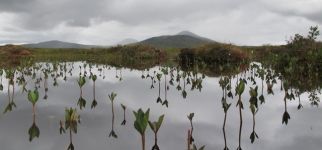Take action
No one organisation or community can adapt to climate change alone. We all share common challenges and opportunities and a wide range of knowledge, skills and experience are needed to help Scotland adapt.
This stage of the process includes:
- Partnership working and leadership
- Collating and presenting adaptation actions
- Build adaptive capacity
- Implement on the ground actions
- Telling others
Partnership working and leadership
In many cases action to adapt will need to be agreed and implemented jointly by a large number of organisations and communities. Formal partnership working arrangements may be needed to enable organisations and communities to set out how they will work together and provide accountability for implementing adaptation actions. Those involved in developing the adaptation actions should be consulted on the type of partnership working and leadership arrangements needed to enable implementation.
Options could include:
- Incorporate work to adapt to climate change as part of the aims and objectives of your community group;
- Build responsibility for partnership working and leadership on adaptation as part of an existing partnership such as the community planning partnership;
- Set up a new partnership focussed specifically on adapting to climate change.
Collate and present adaptation actions
The actions identified in stage 3 ‘identify and prioritise actions’ need to be recorded and presented to the relevant decision makers or those you will need to collaborate with. This can be done through writing an action plan, developing a funding bid, or using any other planning tool that is already part of your community or organisation’s planning cycle.
Build adaptive capacity
A wide range of knowledge, skills and collaborations are required to enable organisations and communities to implement adaptation actions. Developing this knowledge, skills and capacity is called ‘building adaptive capacity’.
You can build the adaptive capacity of your organisation or community by taking actions such as running training and awareness raising sessions and providing guidance documents.
Implement on the ground actions
Adaptation actions that involve implementing ‘on the ground’ actions are best delivered through partnership working and collaboration and will benefit from work to build adaptive capacity
There are often opportunities to implement on the ground adaptation actions as part of planned activities – For example include adaptation measures as part of landscaping or building refurbishment projects. Work with partners to identify opportunities for adaptation actions to be included as part of other projects and initiatives. This can significantly speed up the process.
Some adaptation actions will take longer to implement and may require several stages of design, planning and funding applications. Earlier work to raise awareness, build support for action, establish a long term vision and / or risk assessment process will help build commitment and support for implementing actions that may be more complex and time consuming to deliver.
Tell others
Talk to people about your progress and the benefits that have been achieved from your adaptation actions to encourage further action. It may help to compile all the evidence of the work you have done on the adaptation process into one place. Who are your target audience? Finding out what matters to them will help you decide how you will communicate your work. For example, if your work is part of a community project, you could detail your work in a community newsletter. If it is for your organisation, check if there are report templates you could use, or maybe information can be included in an annual report. If you are a Public Body, consider using the Public Bodies Climate Change Reporting template to detail your progress.
You might also like
Relevant case studies
Developing a city wide adaptation vision and action plan
The Edinburgh Adapts project created a city wide adaptation vision and action plan as part of Adaptation Scotland's partnership projects. Read more
Preserving historic structures with Historic Environment Scotland
Protecting historic structures from climate change with Historic Environment Scotland Read more
Restoring peatlands with RSPB Scotland
Restoring the natural peatlands of the Forsinard Flows nature reserve with RSPB Scotland. Read more


